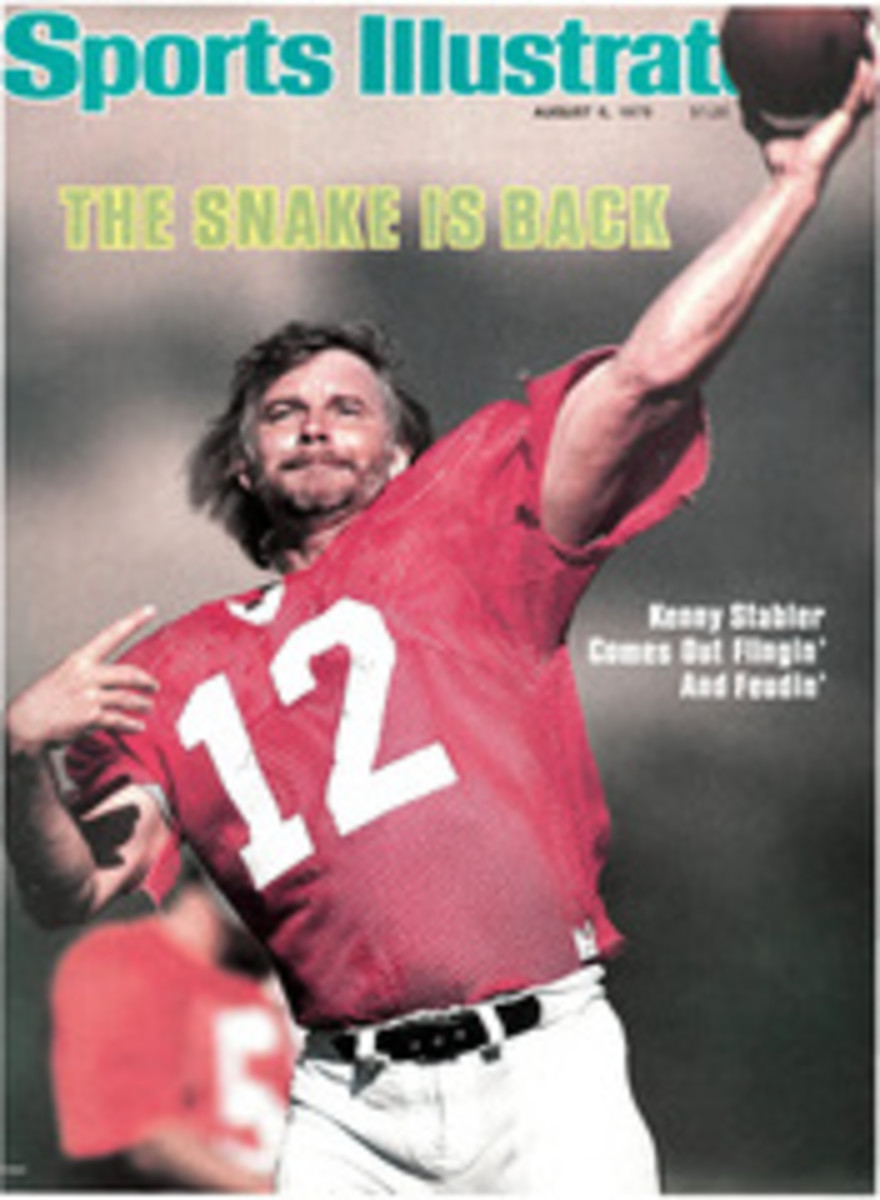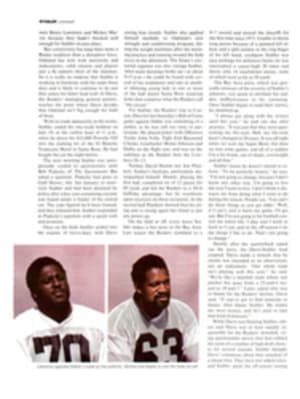
Tea party brewing in the NASL
The pass was the kind soccer players dream about—40 yards cross-field, low and true from the foot of the legendary Franz Beckenbauer. The touring Cosmos, practicing on a patchy field in Argentina, were in a foul mood on a hot November day after a rough loss the night before. Beckenbauer's perfect pass came spiraling out of the sunlight into the deep shadows near the sideline. Even the Kaiser stopped to watch.
Waiting for the pass, with no one to harass him, was 19-year-old Rick Davis, a blond Californian who had quit the University of Santa Clara in his sophomore year to sign a contract with the Cosmos. Davis, who is probably the best U.S.-born player in the NASL, moved too quickly to trap the pass. His body turned awkwardly and when his foot came in contact with the ball, the angle was wrong. The perfect pass glanced out of bounds.
Beckenbauer exploded at Ray Klivecka, the Cosmos' assistant coach, who was running the practice. "So this is the future of America?" he shouted. "This is what you're waiting for? Forget it! Sell the team! It's a joke!"
Judgments like those have made American players like Davis increasingly bitter about their status in the NASL. On the one hand, Beckenbauer's complaint—that American players are not skilled enough to play the game on its highest professional levels—is accurate enough. That estimate is generally shared by foreign players and by foreign and most American coaches. On the other hand, the unhappy home-grown players argue that only game experience can accelerate their progress, and that playing time is precisely what they have not been getting.
While the NASL was not formed to showcase Americans, from the beginning the league has had rules providing that a number of Americans—actually, North Americans—must play. At present an NASL team must start two Americans—either native-born or naturalized Canadian or U.S. players—and six Americans must be carried on the 17-man roster. Next year the number of North American starters will rise to three, but the number on the squad will remain six.
"NASL doesn't mean North American Soccer League," says a disgruntled Nick Owcharuk, 25, a native Chicagoan who is the Tulsa Roughnecks' third-string goalkeeper, "It means Non-American Soccer League."
On a recent weekend Owcharuk's complaint would have been seconded by the 144 North Americans in the league. With all 24 teams in action, only 55 of the 264 starters were North Americans. Although that was seven more than the rules require, 21 of the 55 were Canadians, and 10 were naturalized U.S. citizens, including Italy's "national treasure," Giorgio Chinaglia. There were only 24 homegrown U.S. players, an average of one per team.
"The Americanization of soccer is a joke," snarls Dan Counce, a St. Louis-born sixth-year forward with the Toronto Blizzard. "Instead of the two-man rule being a minimum, it's become the upper limit. The rest ride the bench and get more splinters than game minutes."
Dennis Tueart, a brilliant English winger now in his second season with the Cosmos, goes to the heart of the dilemma when he says, "I started playing soccer when I was three, and I never played anything else. Americans in the NASL began at 13 or so. You can't give me a decade of basic ball skills that have become muscle habits and then expect to beat me on the field. Americans need more early training, although the group in youth soccer today should eventually be very good indeed. For the current pros, it's a battle and there's bound to be casualties. But if you push Americanization too hard, the whole sport here could be finished. Who's going to go to games played on a lower level?"
Ironically, the problem was intensified by the arrival of Pelè in 1975. Pelè's mission with the Cosmos was to evangelize the biggest sport in the world in this important sports country. When he succeeded—when pro soccer began to make money—other clubs' coffers opened to the stars of Europe and South-America and the level of the NASL game rose. Simultaneously, the stock of the American players fell.
Rinus Michels, the famed Dutch coach now piloting the Los Angeles Aztecs, says, "The level of imported players is now so high that I wouldn't dare start more than the two required Americans. Otherwise, I'd get beaten by much-improved competition." The Dallas Tornado's Al Miller, a Pennsylvanian who has coached Hartwick College of Oneonta, N.Y., once used many American pro players. "I just can't carry the American banner anymore," he says. "I was about the only one who tried to work a lot of Americans into the lineup. The foreigners have just proved too good. Right now I'm waving the German flag."
Rationalizing their plight does not make the U.S. players feel any better about it. Billy Gazonas, the winner of the 1977 Hermann Trophy as the outstanding college player in the nation, is a feisty little midfielder for the Tulsa Roughnecks. On a squad that is British-coached and 60% British, he is an occasional starter. "When we practice it's the first-team British against the second-team Americans," he says. "The Americans take practice pretty seriously, and we can beat the Brits a lot. I took down a British player when we were two goals up in a practice one day, and when we were both on the ground I said to him, 'It's 1950, mate.' " Gazonas was referring to an amazing upset, the 1-0 win of the U.S. National team over the mighty English in an early round of the 1950 World Cup. The U.S. was eliminated quickly, and hasn't qualified for the final 16 since.
Gazonas' animus goes beyond teammates. "The English coaches like a long-passing, hard-running game," he says, "but the better soccer colleges here teach the short-pass, field-working style. So they don't understand us, and we don't want to play their way."
Alan Hinton, Gazonas' coach, has a ready answer for that: "The Americans are just going to have to play the English style. After all, we control the sport here, don't we?"
Although NASL coaches come from eight different countries, including two from the U.S., the league is predominantly British. One English coach, Detroit's Ken Furphy, delivered the ultimate transatlantic insult when he shouted at his British starters after a poor game: "You played so badly, I might as well have started the Americans!"
Perhaps the loudest and most articulate advocate of Americanization is Bobby Smith, a tough, flop-haired U.S. defender who sat on the bench with the Cosmos last year and is now starting for San Diego. "Who's looking out for the Americans in the NASL?" he asks, smacking his palm with his fist. "The owners? They can't get their faces out of the trough long enough to be moral. The coaches? They're so scared of losing games they won't take a chance on us. The foreign players? With a few exceptions like Chinaglia and Rodney Marsh [Tampa Bay's English striker], who will help out an American? The old guys who were over the hill in Europe or South America are too insecure with their own starting positions here. As a result, we're getting the shaft right here in our own country. We're the window dressing. They keep telling us to wait, to take our time. Well, we've heard those lyrics before and we want it now."
But they aren't about to get it. Chinaglia cautions that "You can't rush this thing. Americans have a long way to go. U.S. goalkeepers are maybe the best, as a group, of any in the world, because Americans have such great hand-eye coordination. The defenders are very fine, brave and strong, because defending is a relatively easy field position. But at midfield, where a player must distribute the ball and read the flow of the game, Americans are not so hot. And at forward, where you write the script for the game and need great deception and cunning, they haven't got it."
In the care and feeding of home-bred talent, no team has done as much as Chinaglia's Cosmos. They have sent their American second-squadders to Scotland, Germany and Italy to train with First and Second Division reserve squads. But to the Americans, that is not the same as league competition. Says Davis, "They tell you that just practicing with Beckenbauer and Chinaglia and the others will make you a better player, but it won't. The trick is to get a starting slot and hang on. I played center forward all my life, but here I'm a midfielder, and I'm glad I can start."
In June the Cosmos beat Coventry City, an English First Division club, 3-1 in an exhibition game. Because of injuries and a need to rest some of the superstars, eight Americans played, proving, says Long Islander Ron Atanasio, that "although we might not be the most skilled players in the world, at least we're capable of playing like a team on the international level. It did more for our confidence than anything the NASL has ever done for us."
The confidence of American players is even higher in Houston, which leads the Central Division of the American Conference. Kyle Rote Jr., the most publicized American in the early, shaky days of the league, says, "We've started as many as five Americans in our lineup. That proves it's possible." Rote would like to see a limit of five foreign starters per team. "Then we'd see just how good these foreign coaches are supposed to be," he says.
But the reluctance to use the home-growns remains, even in a coach as sympathetic to them as Miller. "You take a kid who grew up with seven pairs of soccer shoes and his mom driving him to practice, and when the going gets really tough, he'll let you down," he says. "The foreigners play the game with guts and blood. You can rely on them."
The non-starting Americans on the Cosmos call themselves the Monday Marauders because they practice the day after games while the first team earns a rest. In the dressing room they have their own aisle of lockers, called American Alley. But the separateness goes beyond that. "When the Cosmos have a party," says Bobby Smith, "it's Chinaglia and Beckenbauer and the continentals in one corner, Tueart and the Brits in another and Alberto and Marinho and the South Americans in another. The Americans stand at the bar, left out of it all. It's not like a team."
But it is like the Non-American Soccer League.
PHOTO
Houston's Rote would get a kick out of a rule that provided more opportunities for Americans.

